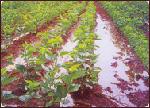Mulberry cultivation
Mulberry cultivation
Mulberry varieties
V1 and S36 are the high yielding mulberry varieties highly suitable for silkworm rearing. These two varieties produce nutritive leaf, which is essential for good growth of silkworm larvae. The characteristics of these two mulberry varieties are as follows:
S-36
- The leaves are heart shaped, thick and light green with glowing nature.
- The leaves have high moisture and more nutrient content.
- About 15,000 to 18,000 Kg of mulberry leaf per year from one acre.
V-1
- This variety was released during 1997 and very popular in the field.
- The leaves are oval, broad in shape, thick, succulent and dark green
- About 20,000 to 24,000 Kg of mulberry leaf yield can be obtained in a year.
Plantation system

Paired row system of plantation with (90 + 150) cm x 60 cm spacing is advantageous over the existing system of plantation with 90 cm x 90cm or 60 cm x 60 cm spacing. The advantages of paired row plantation are
- Spacing between two paired rows facilitates the use of power tiller for intercultural operations and transportation of leaves. It also facilitates the use of drip irrigation system.
- Accommodates more number of plants /acre
- Easy and quick transportation of leaves, which reduces moisture loss.
- Saves labour up to 40% due to shoot harvesting.
Application of fertilizers and manure
- Apply FYM @ 20 MT / Ha/year in 2 equal split doses.
- Apply NPK @ 350:140:140 kg/ha/year for V1 and 300: 120: 120 Kg/Ha/year for S36 in 5 equal splits.
Irrigation
- Irrigate once in a week @ 80-120 mm.
- Wherever, there is water scarcity, the farmers can go for drip irrigation, so that 40 % of the irrigation water can be saved.
New method for raising mulberry in nursery
In sericulture, mulberry saplings are commercially produced from cuttings under raised or flat bed system.
The success of sprouting and vigour of the sapling are greatly influenced by competing weeds, soil moisture, and soil temperature. Since water and labour availability/expenditure on weeding are the hurdles nowadays, a new method of raising mulberry saplings using polythene sheets is developed to overcome these difficulties, which practically proved very effective for successful production of quality mulberry saplings for commercial purpose.
Method
After ploughing the land to 30 to 40 cm depth and application of 8 to 10 metric tonnes of farm yard manure, the land is to be levelled. Nursery beds are prepared with an irrigation channel three fourth common for both sides of beds.
Black polythene sheets cut to the size of 15 feet x 5 feet are to be placed on the bed and 6 to 8 months old disease-free mulberry cuttings (15 to 20 cm length with 3 buds) are to be inserted into the polythene-covered nursery bed soil at the spacing of 10 cm x 10 cm. Channel irrigation is to be done over the polythene itself once in a week or 10 days depending upon the soil texture of the area.
Benefits
- By this method weeds can be totally arrested, as they do not get sunlight. Thus, no weeding is required throughout the nursery period (four months), which saves huge expenditure on manual weeding.
- Since there are no weeds to compete with the growing mulberry saplings, they get the maximum soil nutrients, resulting in high vigour and growth, producing quality saplings. Unlike other methods, irrigation can be reduced to 50 per cent, as the polythene cover over the soil significantly reduces the soil temperature and prevents water evaporation, thus conserving soil moisture.
- Income : By this method, about 2.30 to 2.40 lakhs saplings can be produced per acre in four months period with an increased average income of Rs. 50,000 over the other methods.
Source: B. Mohan, N. Sakthivel & R. Balakrishna, Research Extension Centre, Srivilliputtur; Central Silk Board ; Central Sericulture Research & Training Institute, Mysore
Related resources
Last Modified : 3/1/2020
This topic provides information related to steps t...
This topic provides information about Causes, targ...
This topic provides information about Zero tillage...
This topic covers information related to Acute res...
